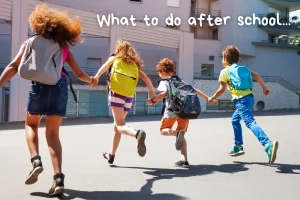
- Trusted by Over 2000 Schools Nationwide
- Top-Rated PD Provider ★★★★★ 4.77
- Save with our Kits & Packages – Shop Now! →
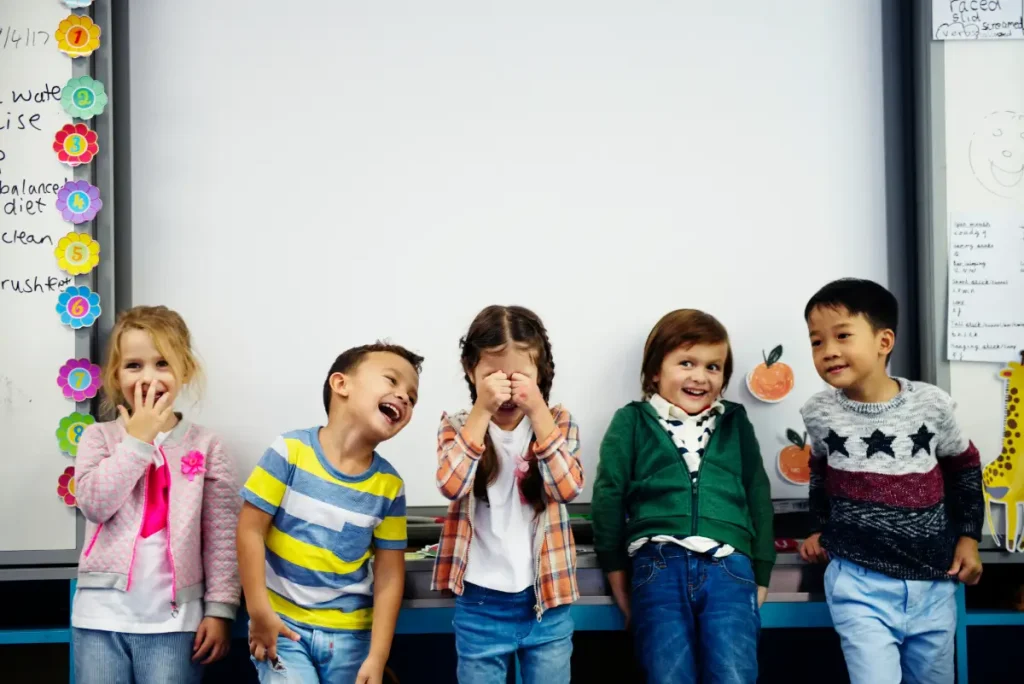
All teachers have experienced days when their students are antsy, disruptive, and unfocused. When those difficult days become more frequent, teachers seek new classroom management strategies for their elementary students. Movement-based lessons and activities can work as an effective form of classroom management for elementary teachers.
Some educators may be hesitant to implement movement-based strategies, fearing that their students will become even more unmanageable. It’s challenging enough to keep students on-task while they’re sitting at their desks. How could they possibly be successfully learning while moving and hopping all around the classroom?
Did you know that kinesthetic activities actually boost student engagement? A recent study by the National Math Foundation found that kinesthetic activities significantly increased student engagement. The study focused on incorporating kinesthetic learning strategies into multiplication lessons for 492 students in 3rd through 5th grade. Teachers implemented aspects of the Math & Movement program in their classes, including active math movements and jumping on floor mats.
Engaged students are easier to manage. Physical activity boosts blood flow and oxygen levels in the brain, which in turn improves learning comprehension and memory retention. Encouraging students to move can be the key to effective classroom management, instead of trying to force them to sit still and keep their energy pent-up.
“If your students are sitting for more than 20 minutes, that’s going to fuel poor behavior,” says Yolanda Crowley, a Math & Movement team member with over 22 years of teaching experience.
We’re sharing some effective classroom management strategies for elementary teachers focused on getting students active and moving. The following kinesthetic strategies can be used for small groups or whole classes.
“I always start my lessons with cross-body movements,” Yolanda says. Cross-body movements engage both sides of the brain, which makes it easier to digest and remember new information.
The easiest way to engage both hemispheres of the brain is to cross the vertical “mid-line” of the body. For example, reaching your right hand down to your left foot crosses this mid-line.
Waking up both sides of the brain leads to better engagement and, therefore, an easier classroom to manage. The Math & Movement Training Manual is filled with cross-body exercises to practice skip counting. Get your elementary students standing, moving, and reciting numbers aloud!
Another classroom management strategy that Yolanda uses is playing music during kinesthetic activities. Upbeat music is a great way to get students moving and dancing. Have your students practice cross-body movements or active math movements to the rhythm of a song. Give your students the power of choice by taking genre or song requests.
Allowing students to have agency over their learning is key to high engagement levels. Once you’ve led several cross-body movements and active math movements with your class, allow them to come up with their own movements or dances.
Yolanda asks her class, “Can anyone think of another way to practice skip counting by 4s?” This is a chance for kids to be creative! The whole class can practice the new move together.
After practicing cross-body movements and active math movements, Yolanda has her class hop on a Math & Movement mat. She tells her class to take turns hopping on the mat, just like they are playing a game.
Having students line up on both sides of the mat, particularly any Skip Counting Mat, allows them to see the mat and what the hopping student is doing.
Another strategy to facilitate taking turns (and practice more skip counting) is to assign each student a number. Student number one will hop first, student number two second, and so on. Shake things up with different ordering prompts on different days. For instance, “Even numbers will hop first today!” or “Multiples of three will hop first today!”
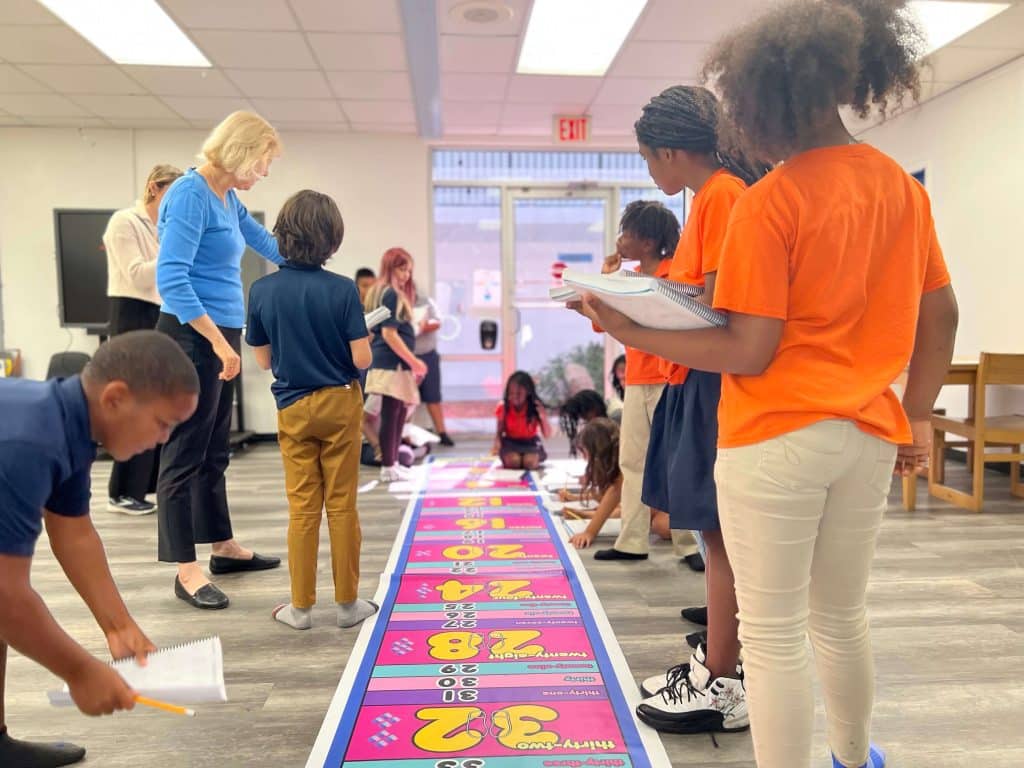
One educator who participated in the Mighty Multiplication Project found that allowing her students to play their own games on the mat before starting the lesson helped with effective classroom management. Set aside 5-10 minutes for a student-led activity to review the previous day’s lesson.
The educator commented, “Just having a ‘games’ time at the start [of each lesson] helped tremendously with engagement, focus, and energy levels!”
Students standing around the mat may be tempted to shout out the answer to their peer who is hopping and trying to solve a problem. Effective elementary classroom management includes giving these students who are waiting for a task to complete so that they do not get bored and impatient.
Encourage students to cheer for their peer hopping on the mat. Challenge them to come up with more questions to ask the student hopping. For instance, if the lesson is skip counting by 4s, a student could ask their peer, “What number comes after 12 when skip counting by 4s?”
Yolanda loves to use peer teaching with Math & Movement mats as a classroom management strategy. She finds that pairing a higher-level student with a lower-level student to work together is effective. It eases pressure on the lower-level student. The strategy is even more effective if the two students paired together are friends.
Give each student their own worksheet and clipboard. Students can work together as a class to solve problems using movements or mats. Each student will have their own worksheet to complete, but you’ll still be fostering teamwork among your class by allowing them to work and move together.
Kinesthetic strategies can be incorporated into the most simple parts of your school day, including when you need to get your class’s attention. Yelling is not an effective elementary classroom management strategy. Instead, try giving students a movement-based task.
When the class is talking and distracted, say, “If you can hear me, put your hand on your head.” The students closest to you will do so. Other students will notice and wonder why they are doing that. Repeat your instruction until the whole class catches on.
Assigning students jobs is a great way to facilitate activities and foster responsibility. When utilizing Math & Movement materials, you can assign jobs such as “Setup Crew” and “Mat Roller.” The Setup Crew can find, unroll, and tape down a mat for a lesson. The Mat Roller can roll up and put away the mat at the end of the lesson. Rotate student jobs weekly.
Giving students jobs empowers them and gives them an active role in the day’s lesson. Plus, you’ll create a classroom culture in which everyone contributes, and all students feel included.
A simple change in scenery can increase student engagement. Lay out a Math & Movement mat in the hallway or the gym. With extra space on the playground or blacktop, your students can create bigger movements and dances.
It is okay to use incentives to get students to follow classroom rules. Teachers use a variety of reward systems. Prizes can be anything from a sweet treat at the class’s holiday party or an extra 5 minutes of recess.
Math & Movement team member Katie still remembers the “Blue Ticket” reward system her third-grade teacher used. Throughout the week, each student in her class could earn blue tickets for good behavior or academic achievements. And of course, blue tickets could be taken away for poor behavior.
Every Friday, the class had the opportunity to spend their blue tickets on prizes like bouncy balls, erasers, or the grand prize – a pass to sit at the teacher’s desk for a day! Hearing the teacher say, “You just earned a blue ticket!” was so gratifying as a kid!
Furthermore, once a student knows they’ve made their teacher proud, the student won’t want to let them down in the future. This encourages good behavior to continue.
Adding movement to your classroom management plan wherever you can will improve learning comprehension, student behavior, and engagement levels. Movement is a great way for young elementary school students to burn off some energy and exercise. Plus, movement-based learning creates opportunities for teamwork, creativity, and, most importantly, fun!
The Math & Movement program can aid in successful classroom management for elementary teachers. Activities can be adapted to work for small groups or whole classes. Students participating in peer teaching will be able to connect over movement. Class no longer has to be stationary and stagnant. Every lesson plan can become active and energetic!
Encourage movement for elementary students instead of trying to force them to sit still. Movement-based teaching strategies improve students’ learning comprehension and engagement levels.
Start lessons with cross-body movements to engage both sides of the brain. Allow students to lead games, cheers, and dances that help them remember the lesson they are working on. Assign students jobs and implement peer teaching activities to empower students and build community in your classroom.
Students are unlikely to be engaged with their lesson when the classroom is disruptive and distracting. Engaged students are successful learners. A classroom management plan teaches children to respect their teachers and find value in school lessons.
Students take turns hopping on a floor mat. The students not hopping can stand around the mat and participate in the lesson in other ways. They can cheer for the student hopping, chant the numbers aloud as the student hops, or come up with other questions to ask the student hopping. During peer teaching activities, students can work together and use floor mats as a tool to solve problems.
Feature image by rawpixel.com on Freepik
Movement isn't just for recess
Want to get started with movement-based learning right now? Enter your email to get our training manual with over 250 active math movements. No materials necessary!


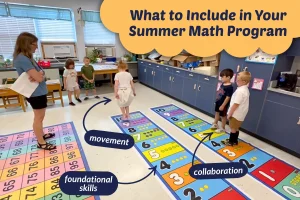
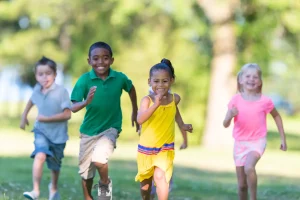
Subscribe to Our Newsletter
We never share or sell your data.
Please leave your email and a quick note for us. We will get back to you soon! In the meantime, here are answers to some of our most common questions:
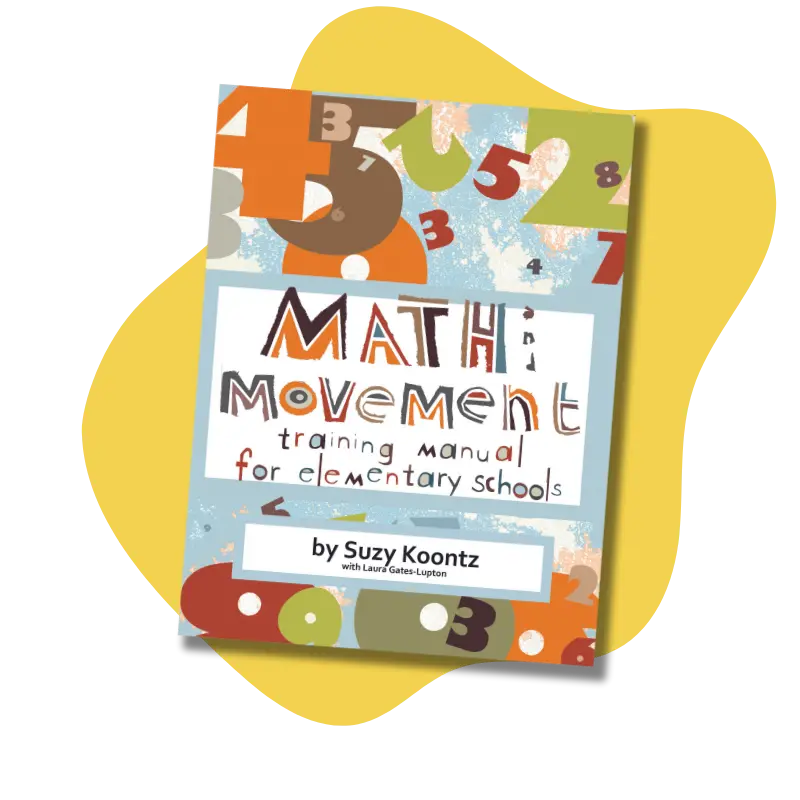
Enter your email to get our training manual with over 250 active math movements. No materials necessary!
We never share or sell your data.